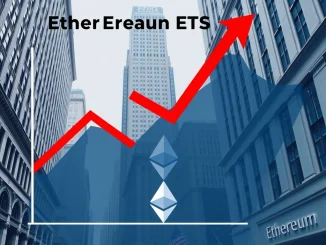
Are you following the latest movements in the crypto ETF space? Recent data reveals a concerning trend in the U.S. spot Ethereum ETFs market. For the seventh consecutive trading day, these ETFs have experienced net outflows, signaling a potential shift in investor sentiment. Let’s dive into the specifics of what’s happening with Ethereum ETF outflows and what it could mean for the broader crypto market.
What’s Driving the Spot Ethereum ETF Outflows?
On April 16th, U.S. spot Ethereum ETFs collectively saw a net outflow of $12.1 million. This marks a continuation of a week-long trend, raising eyebrows across the crypto investment community. To understand the full picture, let’s break down which ETFs are contributing to these outflows and which are bucking the trend.
- Grayscale’s ETHE: Leading the outflows, Grayscale’s Ethereum Trust ETF (ETHE) experienced a significant $8.2 million net outflow. This continues a pattern seen with Grayscale’s Bitcoin Trust (GBTC) after its conversion to a spot ETF.
- BlackRock’s ETHA: Following Grayscale, BlackRock’s iShares Ethereum Trust (ETHA) also saw notable net outflows of $4.3 million. BlackRock’s ETHA has generally been seen as a strong performer since the launch of spot ETFs, making this outflow particularly noteworthy.
- Franklin Templeton’s EZET: Franklin Templeton’s EZET also contributed to the overall negative flow, with $1.8 million in net outflows.
- Grayscale’s Mini ETH (Unknown Ticker): Interestingly, amidst the broader outflows, Grayscale’s ‘mini’ Ethereum ETF witnessed a net inflow of $2.2 million. This suggests a possible investor preference for lower-fee options or strategic portfolio adjustments within the Grayscale family of ETFs.
- Other ETFs: The remaining spot Ethereum ETFs reported no change in their holdings on April 16th, indicating a mixed landscape within the sector.
Spot Ethereum ETF Outflows: A Detailed Look at April 16th
To get a clearer picture of the situation, let’s look at the data in a table format:
[table]
| ETF Ticker | Net Flow (April 16) |
|———————-|———————|
| Grayscale ETHE | -$8.2 million |
| BlackRock ETHA | -$4.3 million |
| Franklin Templeton EZET | -$1.8 million |
| Grayscale Mini ETH | +$2.2 million |
| Other ETFs | $0 million |
| **Total Net Outflow** | **-$12.1 million** |
[/table]
As you can see, while Grayscale’s mini ETH saw positive movement, the significant outflows from ETHE, ETHA, and EZET drove the overall net outflow figure into negative territory.
Why Are Investors Pulling Back from Ethereum ETFs?
Several factors could be contributing to the recent ETF outflows. Understanding these potential drivers is crucial for gauging the future trajectory of spot Ethereum ETFs:
- Profit Taking: After the initial excitement and inflows following the launch of spot Ethereum ETFs, some investors might be taking profits. The price of Ethereum has seen significant volatility, and some investors may be locking in gains.
- Market Uncertainty: The broader cryptocurrency market can be influenced by macroeconomic factors, regulatory developments, and overall risk sentiment. Uncertainty in any of these areas could lead investors to reduce their exposure to riskier assets like crypto ETFs.
- Grayscale ETHE Dynamics: The continued outflows from Grayscale’s ETHE could be attributed to its higher fee structure compared to newer ETFs. Investors might be shifting to lower-fee options, even within Grayscale’s own offerings, as seen with the inflow into the mini ETH product.
- Rotation into Bitcoin: With Bitcoin’s halving event recently occurring, some investors may be reallocating capital from Ethereum to Bitcoin, anticipating potential price appreciation in Bitcoin post-halving.
- Alternative Investment Opportunities: The broader financial market offers various investment options. Changes in yields in fixed income or opportunities in other asset classes might be diverting capital away from crypto ETFs temporarily.
What Does This Mean for the Future of Spot Ethereum ETFs?
While seven consecutive days of net outflows are noteworthy, it’s important to maintain perspective. The spot Ethereum ETF market is still relatively new, and fluctuations in flows are expected. Here are a few key takeaways and considerations:
- Early Days: Spot Ethereum ETFs are still in their early stages of adoption. It will take time to establish a stable pattern of inflows and outflows. Short-term fluctuations should be viewed within the context of a developing market.
- Competition and Fees: The ETF landscape is competitive. ETFs with lower fees and strong brand recognition may attract and retain more assets over time. Grayscale’s move to offer a mini ETH ETF is a clear response to this competitive pressure.
- Long-Term Potential: Despite recent outflows, the long-term potential for spot Ethereum ETFs remains significant. They offer a regulated and accessible way for institutional and retail investors to gain exposure to Ethereum.
- Market Sentiment is Key: The direction of ETF flows will heavily depend on overall market sentiment towards Ethereum and cryptocurrencies in general. Positive developments in the Ethereum ecosystem, regulatory clarity, and broader market bullishness could reverse the current outflow trend.
Final Thoughts: Navigating the Ethereum ETF Landscape
The recent concerning net outflows from U.S. spot Ethereum ETFs serve as a reminder of the dynamic nature of the cryptocurrency market. While the $12.1 million outflow on April 16th and the seven-day streak are significant data points, they don’t necessarily indicate a long-term crisis. Instead, they highlight the ongoing evolution of the crypto ETF market, the competitive pressures among issuers, and the sensitivity of investor flows to market conditions and sentiment. Keep a close eye on these trends as they unfold – they offer valuable insights into the broader health and direction of the crypto investment space.



